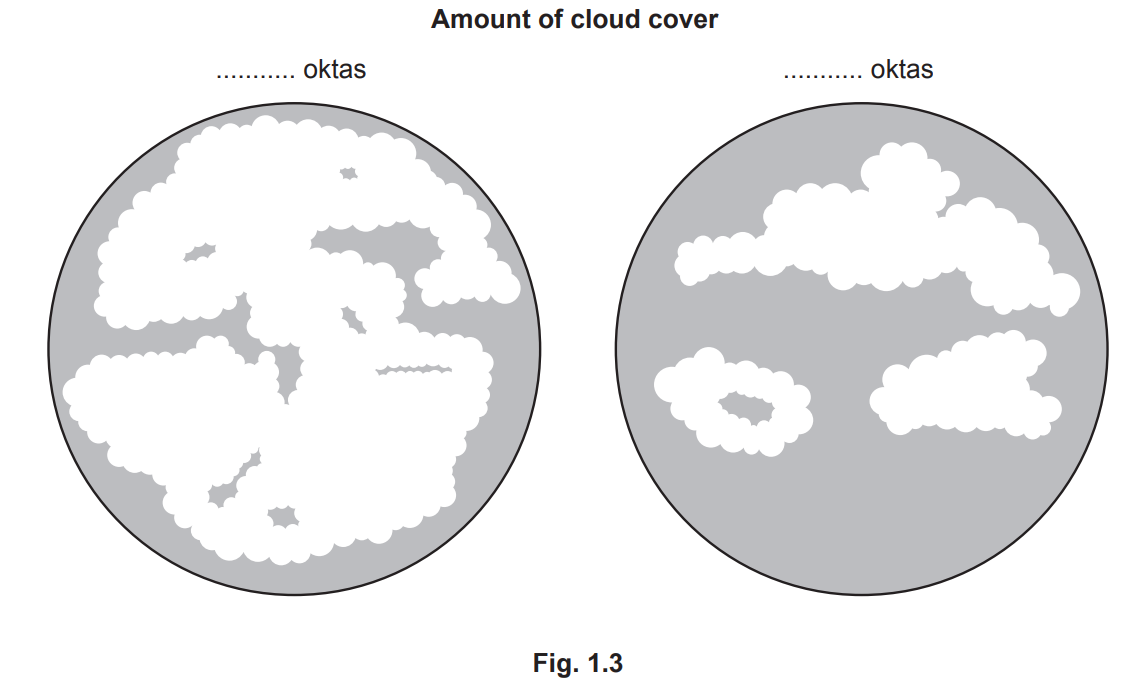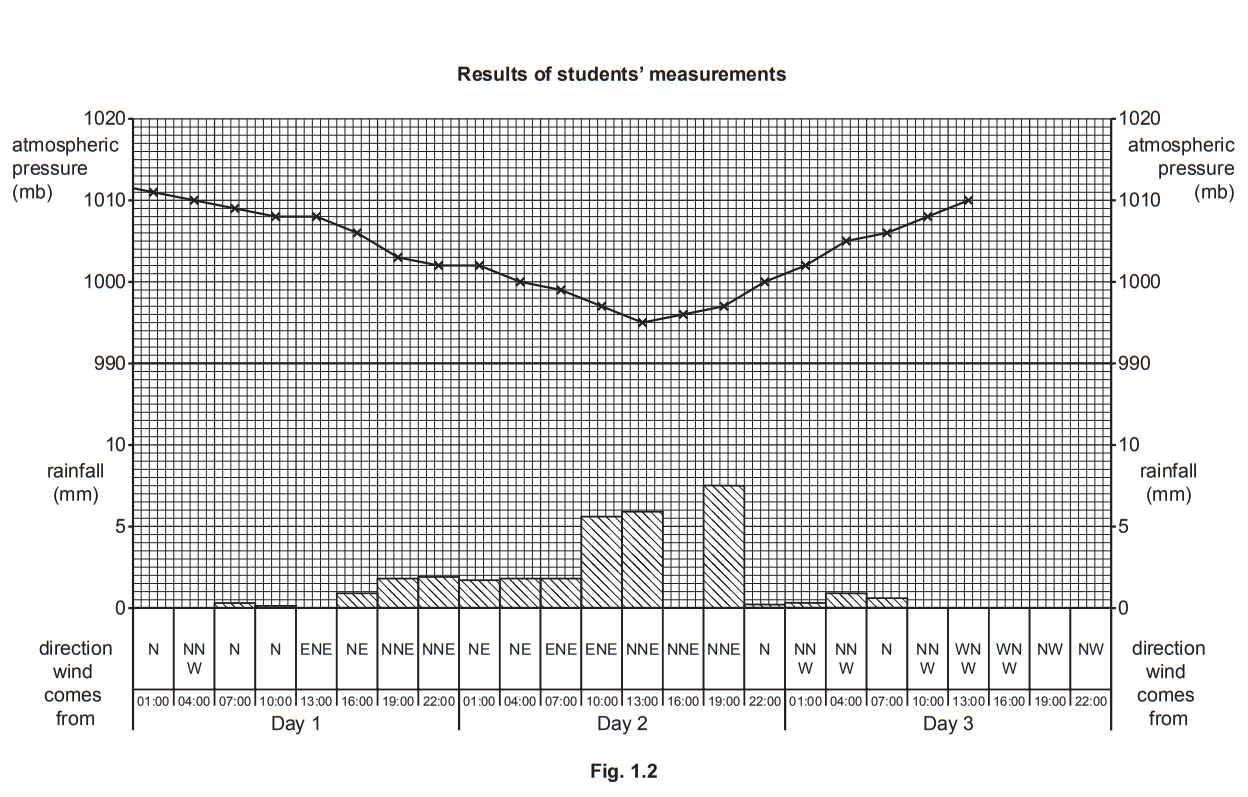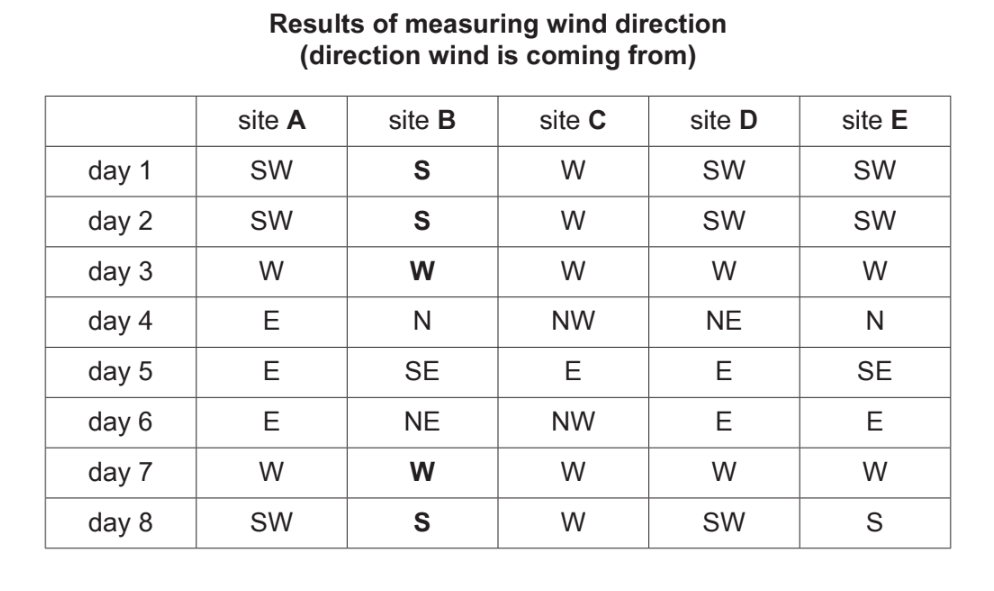Study Fig 1, which shows weather recording equipment

Fig 1 - Weather recording equipment
Name this equipment that is used to record weather
Did this page help you?
Study Fig 1, which shows weather recording equipment

Fig 1 - Weather recording equipment
Name this equipment that is used to record weather
Did this page help you?
A feature of weather which may vary over a small area is relative humidity.
| Definition | Tick( |
| the amount of moisture in the air during the day compared to the night | |
| the amount of moisture in the air as a percentage of the total moisture it could hold at that temperature |
|
| the maximum amount of moisture in the air when it is warmed up | |
| the percentage of moisture in the air when it is raining compared to when it stops raining |
[1]

Did this page help you?
A pair of students investigated how the amount of cloud cover and cloud type had changed over three days.



Did this page help you?
Look at Fig. 1.1.

Fig. 1.1
Suggest reasons why each of the following vary between the sites in the city centre square:
Did this page help you?
Fig. 4.1 shows the sunshine hours per month for an area in southern England.

Fig. 4.1
[1]
Did this page help you?
Fig. 4.2 (below) shows some clouds.

Describe the clouds shown in Fig. 4.2.
Did this page help you?
Describe how cloud cover is measured.
Did this page help you?
Students at a school in Seattle, USA, measured atmospheric pressure, temperature and rainfall during 15 days in November. They tested the following hypotheses:
Hypothesis 1: Temperatures increase as atmospheric pressure rises and decrease as atmospheric pressure falls.
Hypothesis 2: There is a relationship between atmospheric pressure and daily rainfall totals.



[1]
[1]
Did this page help you?
Students in Northern Ireland were studying the topic of weather and how to measure and collect weather data. The students noticed that the weather was forecast to change over the next three days, so they decided to take some measurements to investigate these changes.
One pair of students decided to test the following hypotheses:
Hypothesis 1: As atmospheric pressure changes rainfall amounts will vary.
Hypothesis 2: Atmospheric pressure affects the direction from which the wind blows.
The two students measured atmospheric pressure, rainfall and which direction the wind was blowing from. They took measurements every three hours using a combination of traditional and digital instruments.
| Tick (✓) | |
| anemometer | |
| barometer | |
| hygrometer | |
| thermometer |



| Atmospheric pressure (mb) | 1002 |
| Rainfall during the last three hours (mm) | 0.3 |
| Wind direction | NNW |
Did this page help you?
Geography students from Bantry in south west Ireland did a weather investigation. They wanted to see if there was a link between atmospheric pressure and rainfall, and a link between wind direction and temperature.
The students agreed to investigate the following hypotheses:

[2]

| Time | Measurement number |
Atmospheric pressure (mb) |
Rainfall during last three hours (mm) |
|
| Day 1 | 10.00 | 1 | 1009 | 0.1 |
| 13.00 | 2 | 1008 | 0.5 | |
| 16.00 | 3 | 1005 | 0.6 | |
| 19.00 | 4 | 1003 | 0.4 | |
| 22.00 | 5 | 1002 | 0.2 | |
| Day 2 | 01:00 | 6 | 1001 | 3.6 |
| 04:00 | 7 | 999 | 1.0 | |
| 07:00 | 8 | 998 | 2.8 | |
| 10:00 | 9 | 997 | 0.8 | |
| 13:00 | 10 | 997 | 4.6 | |
| 16:00 | 11 | 998 | 3.9 | |
| 19:00 | 12 | 999 | 2.0 | |
| 22:00 | 13 | 1002 | 0.1 | |
| Day 3 | 01:00 | 14 | 1003 | 0.1 |
| 04:00 | 15 | 1004 | 0.1 | |
| 07:00 | 16 | 1005 | 0.1 | |
| 10:00 | 17 | 1007 | 0.2 | |
| 13:00 | 18 | 1010 | 0 | |
| 16:00 | 19 | 1011 | 0 | |
| 19:00 | 20 | 1011 | 0 | |
| 22:00 | 21 | 1013 | 0 | |
| Day 4 | 01:00 | 22 | 1016 | 0 |
| 04:00 | 23 | 1015 | 0 | |
| 07:00 | 24 | 1017 | 0 |

|
Highest atmospheric pressure |
Lowest atmospheric pressure |
The students’ measurements of wind direction and temperature are shown in Table 2.2 (Insert).
Table 2.2
Wind direction and temperature data
| Time | Measurement number |
Direction wind came from |
Temperature to nearest degree (°C) |
|
| Day 1 | 10:00 | 1 | SE | 11 |
| 13:00 | 2 | SE | 13 | |
| 16:00 | 3 | SE | 11 | |
| 19:00 | 4 | ESE | 12 | |
| 22:00 | 5 | ESE | 10 | |
| Day 2 | 01:00 | 6 | SSE | 9 |
| 04:00 | 7 | S | 10 | |
| 07:00 | 8 | S | 9 | |
| 10:00 | 9 | SSE | 10 | |
| 13.00 | 10 | SSE | 12 | |
| 16:00 | 11 | NNW | 10 | |
| 19:00 | 12 | NNW | 9 | |
| 22:00 | 13 | NW | 7 | |
| Day 3 | 01:00 | 14 | NNW | 7 |
| 04:00 | 15 | NNW | 6 | |
| 07:00 | 16 | N | 5 | |
| 10:00 | 17 | N | 7 | |
| 13:00 | 18 | NNW | 9 | |
| 16:00 | 19 | NNW | 8 | |
| 19:00 | 20 | NNW | 7 | |
| 22:00 | 21 | N | 4 | |
| Day 4 | 01:00 | 22 | N | 4 |
| 04:00 | 23 | N | 3 | |
| 07:00 | 24 | N | 3 |

Did this page help you?
Students investigated differences in weather in a city centre square. Fig. 1.1 shows the square which is pedestrianised. They identified five sites in the square where they could measure temperature, wind direction and wind speed at midday (12:00 hours) and in the early evening on eight consecutive days.

Fig. 1.1
The students investigated the following hypotheses:
Hypothesis 1: Midday temperatures are higher at sites A, B and C than at sites D and E.
Hypothesis 2: Wind direction and wind speed vary more at site C than at site E.



| Tick ( |
|
| wind dial | |
| wind gauge | |
| wind vane |
[1]





| Tick( |
|
| Wind direction varies more at site C than at site E | |
| Wind speed varies more at site C than at site E |
[3]
Did this page help you?
A student who was studying weather did fieldwork to measure and record rainfall at her school. To extend her fieldwork she decided to compare her results with data from a weather station at the local university about 50km away from the school.
The student decided to investigate the following hypotheses:
Hypothesis 1: At the school rainfall is higher on days when the wind is blowing from the west
Hypothesis 2: Rainfall is higher at the school than at the university.
[2]
[4]
 Fig. 1.1
Fig. 1.1 [3]
| day | rainfall (mm) |
wind direction from |
| 1 | 2 | NW |
| 2 | 3 | NW |
| 3 | 5 | W |
| 4 | 0 | SW |
| 5 | 0 | S |
| 6 | 0 | S |
| 7 | 3 | SW |
| 8 | 8 | W |
| 9 | 4 | W |
| 10 | 0 | NW |
| 11 | 0 | N |
| 12 | 0 | N |
| 13 | 0 | NE |
| 14 | 0 | NE |
| 15 | 2 | NE |
| 16 | 2 | N |
| 17 | 1 | N |
| 18 | 3 | NW |
| 19 | 7 | W |
| 20 | 2 | NW |
| Average | 2.1 |
[2]
Daily rainfall measurements when wind is
coming from different directions

Fig. 1.2
[3]
[2]
[2]
[2]
| rainfall on one day at the university | 4.0mm |
| average daily rainfall at the university | 3.2mm |

Fig. 1.3
[3]
| unit of measurement | tick (✓) |
| degrees | |
| millibars | |
| millimetres | |
| oktas |
[1]
| type of cloud | description | |
| cirrus | Low altitude grey clouds which occur in layers; rainfall is usually light and is described as ‘drizzle’. | |
| cumulus | High altitude white clouds which appear ‘wispy’ or look like feathers; no rain falls. | |
| stratus | Low altitude clouds which are separate from each other and appear ‘fluffy’ or look like cotton wool; rain showers may occur. |
[2]

[4]
Did this page help you?
Students at a school in Seattle, USA, measured atmospheric pressure, temperature and rainfall during 15 days in November.
The students measured the maximum and minimum temperature for each day using a thermometer like the one shown in Fig. 1.1. Explain how the students would use the thermometer to measure temperature.

[4]
Did this page help you?
The results of the students’ measurements of atmospheric pressure are also shown in Table 1.1 and in Fig.1.2.
| anemometer | barometer | hygrometer |
[1]
[1]



Did this page help you?




Table 1.1

Did this page help you?


Did this page help you?